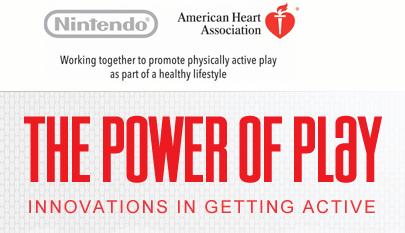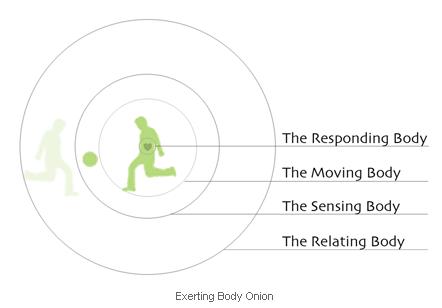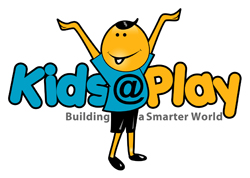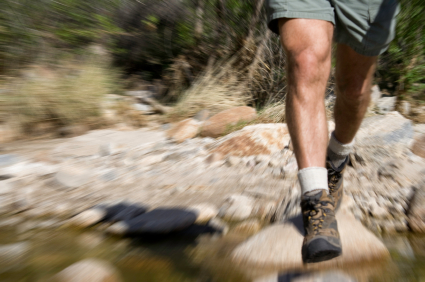 Feb 3, 2011 When I was invited to attend the “Power of Active Play” summit hosted by the American Heart Association and Nintendo, my synapses were firing in Howard Rheingold mode, wondering if this convening was going to be a glorified commercial for the gamification of life.
Feb 3, 2011 When I was invited to attend the “Power of Active Play” summit hosted by the American Heart Association and Nintendo, my synapses were firing in Howard Rheingold mode, wondering if this convening was going to be a glorified commercial for the gamification of life.
I may not be wearing the same rose-colored shades of Jane McGonigal’s Wall Street Journal article about the powerful ‘save the world’ benefits of video games (though I love her positive strategies for solutions-based problem-solving) but I certainly DO embrace the opportunities for tech and gaming in creating next generation learning tools.
I admittedly have a ‘wean from the screen’ bias for playing outdoors, BUT I also completely “get it” that the word “game” is no longer a four-letter word when it comes to kids’ health and fitness…As I said in Part One, Play WORKS and games are simply not an ‘either/or’ proposition, but an ‘and/also’ prescription for maximizing the power of play both online and off, indoors and out.
This week alone cold weather climates have literally frozen cities and school services into quiet blocks of ice and closure, and while some may be dragging their sleds to the top of hills and building igloos, there are plenty of families who relish the options of indoor exergaming for kids to get their ya-yas and energy out. (Great article on 11 Scientific Benefits of Play for those who need a reminder beyond “it’s essential and it’s fun!”)
In all honesty, I wasn’t sure WHAT to expect from the conference.
I can attest that it was much more ‘power’ than ‘play’ since some of the brightest minds in public health, wellness, technology and gaming communities dove into open session projections of futuristic thinking to present opportunities and challenges in the next five years.
I almost showed up in yoga pants since there was a ‘recess’ area touted, but realized I’m all too often in hopeful hands-on mode, when most school systems and workplaces are much more MIND than body focused.
AHA scientists reiterated the historical shifts from outdoors to indoors post industrial revolution and how we’re now “paid to think” as infovores, though we’re paying a terrible price for spending “90% of our waking hours on our butt.”
The summit ‘recess’ area was a hoot, (more on the sociological observations there later) but I knew I found a kindred tribe when the opening remarks yielded wry witty shoutouts both to and from the stage:
“Why are we so sedentary?” “Talks like this!” …
“When do kids stop moving and learn to start sitting?” “How about school?!”
Clearly, this heart-healthy crowd of brilliant electrophysiologists, neuroscientists, and health and education rockstars chatting about active innovations in play was on the same page in terms of hoping for more ‘active recess’ WITHIN the conversational format.
Ironically, my favorite talk of all, (Elizabeth Cushing representing Playworks.org) was the only speaker who specifically integrated the audience into her point about physical engagement and relatedness beyond machines and tech tools.
Using a simple “stand up if this statement applies to you” classic engagement approach, she created a welcome stretch break and made a poignant point about the value of participatory PLAY in itself.
As heads craned around the room to see who was who in terms of audience composition, listening to the content intensely “if you are a researcher stand up, if you are a parent, stand up, etc” she beautifully reinforced that there is an intrinsic motivation to PLAY and be INCLUDED regardless of whether or not anyone ‘wins’ (negates the need for competition as an element)
This human need for social inclusiveness has been called out in countless studies on health and stress, with some even ranking it up there in the primal needs category of risk management implying it’s up there with smoking and obesity in preventable causal health implications (see NYTimes wellness article citing new PLOSMedicine studies about social relationships and mortality risk–ahem, somehow looking at my teen and her social peer group sometimes I feel it bucks this study in the other direction 😉
Anyway, suffice it to say Playworks “had me at hello” not just with the icebreaker and useful mind/body exercise (I’m stealin’ that tactic for sure) but the eloquence of ‘what’s really happening with play’ on the playgrounds which I’ve seen firsthand in my own research, especially with ‘urban/at risk’ youth…
Here’s an excellent summary from Playworks recent Good Morning America visit:
Play itself is in dire need of an overhaul as it’s in desperate jeopardy with kids needing a primer on the basics, both physically and socioemotionally, a sad statement of our times, as reflected in my own ’06 Verb YellowBall post where kids were ‘prompted’ to play and handed a ball. (See the great CDC campaign targeting tweens before pulling the plug, sigh)
 When I observed kids swarming toward a mega-play area near concert/arena environs, it was interesting to watch kids respond to being handed the yellowball in two ways: possession (“can I keep it?”) and confusion (“what do we do with it?”)…
When I observed kids swarming toward a mega-play area near concert/arena environs, it was interesting to watch kids respond to being handed the yellowball in two ways: possession (“can I keep it?”) and confusion (“what do we do with it?”)…
This is definitely part and parcel of the larger ‘recess’ conundrum that Playworks expressed at the summit, which I want to write about in a separate post devoted to their fabulous work REintroducing play via recess/school based programs. (they provide trained, full-time coordinators to more than 100,000 students at 250 low-income urban schools in 15 cities in nearly every region of the country, with amazing outcomes, more on that later)
So for now, consider THIS part two post, as my “myth debunker” in the series…
This is a basic overview of what I learned anew about the power of play and what I tossed out of my mental relay in terms of misconceptions pertaining to gaming, consoles and the level of fitness achievable through social play on and offline. (think of it as a flashback to the old Rolling Stones magazine “perception/reality” ad campaign)
Of course, I wouldn’t be worth a whit of media analysis if I didn’t ‘follow the money’ to note the gargantuan economic engine ‘in play’ here and argue both sides of the, er…coin as to why this exergaming market is bloating into HUGE proportions…
So let’s start there… After all, playing outdoors is free.
With over 20 million copies of WiiFitPlus sold in the US alone, nine computer games sold every second in 2009 and growth of the industry pegged at “five times more than the national economy” it’s lucrative as well as practical to leverage exergaming to tackle obesity as an Rx prescriptive.
Active play enthusiasts trotted out plenty of evidentiary data about exergaming used in PE to engage kids and Stephen Yang who works with the GamesForHealth.org project and ExerGame Network captured it visually in my own favorite media of show-n-tell choice, using Animoto (see below)
That said, having worked with schools to amp up physical and nutrition interventions observing playgrounds with kids weekly for years, lining up and engaging with expensive tech toy screens is not pragmatic, scalable, or even desirable, imho, and Playworks research and studies on Why Play Matters can further explain WHY.
I personally find HUGE merit in integrating the shiny penny aspects of fun exergaming technology that is actively engaging the ‘lower 20% of the sedentary spectrum” who needs and benefits from movement the MOST.
That’s part of the usefulness and challenge of a summit like this, where scientists, child health advocates, and industry pros can brainstorm together in ‘what if’ style to keep trying new ways to get past the ‘perceived joylousness’ of ‘working out’ (even the phrase sounds laborious!) and shifting towards the purity of play and fun.
Not sure when “play” became “work” but somewhere along the cultural continuum, “fun and games” started taking on an electronic, screen-based focus and child’s play shifted from the ramp-n-rev of the recess bell to brain-based focus.
Critics of exergaming have focused largely on accusations of displaced outdoor time with more screen time, and this is a valid concern if viewed as ‘either’ rather than ‘and’…(again, not remotely recommending same)
To give you a feel for constructive analysis and merits on ‘both sides’ of this debate via studies, flick through the slideshare below…
I have MUCH more to say about how we can use active games (not necessarily electronic!) to get kids up and moving throughout the school day…
First, let’s do some myth-busting of gaming & play:
Stereotypes: Perceptions run the gamut—Mythology of teens, geeks staring at screens in dark rooms swigging Mountain Dew playing ‘twitch games’ requiring little activity than hand/eye coordination or plotting nefarious antisocial Columbine capers in Lord of the Flies mode needs kicked to the curb
Realities: Only 25% of gamers are under 18, 49% are 18-49, 26% are 50 and over…women now make up 40% with games being used not only by kids but adults ranging from workplace performance to lifestyle behavioral/medical interventions and grandparents needing some post-hospitalization WiiHab.
Stereotypes: Gamers as anti-social loners lacking peer engagement or having behavioral issues is (in gaming parlance) “an epic fail”
Realities: Gaming itself has ‘gone social’—48% of parents now are gaming with kids once a week, 2010 statistics revealed almost 70% of gamers play WITH others (up from 50% in 2006) and some are even forming ‘a league of their own,” yielding leaderboards, virtual challenges, fitness groups that convene in community settings, the works.
Stereotypes: For exercise to have cardiac effect the formula tends to focus on 30+ minute chunks of time 3X a week 30 minutes minimum
Realities: Even intervals of 10minutes 3X a day to get to 30 minutes of carved out time ‘helps’ to get people moving particularly in ‘compromised’ individuals reiterating that “exercise is most beneficial for the least active part of the population.”
It’s mission-critical to get that bottom 20% of the population up and moving. If we can use video gaming to reach those “unwilling or unable” to make changes, some of whom are already sedentary, immobile or hard to wean from the screen, this could be a huge, very solid first step Rx.
Stereotypes: Wrist work and mini-exertion shifting bodyweight doesn’t do much unless you’re coming out of full inertia, in short, it’s not ‘real’ exercise.
Realities: Cardio games are getting even more pumped up with full body kinetics in use, and not just WiiFitPlus and aerobic exergaming studies…No more eyerolling about light to moderate stretching, yoga, and exercise capabilities…
Here are some of the highlights from CES11 Kids@Play about motion control systems and more reported by the Cooney Center…
And here’s American Center for Children & Media’s David Kleeman on HuffPo in a great piece titled, “I second that E-motion” all about his experience at CES11 (Computer Electronics Show) as he writes….
“…There are new devices — like Microsoft’s Kinect for the Xbox 360 and gesture-recognition technology from Omek Interactive — liberate kids from controllers and wires, engaging the entire body and upping the intensity…The first time I tried Kinect, I swayed tentatively to control my whitewater raft.
Quickly, I learned that the game would respond only to energetic side-to-side springing.
New York Times technology columnist David Pogue wrote that you can’t play Kinect sitting down, and that soon “we’ll be hearing doctors say, ‘I think your kids really need to play more video games.'”
 I got to see just how amped up some of the heavy “exertion games” can get via Stanford’s Fulbright Fellow Floyd Mueller who gave us a wild demo of “exertion interfaces’ where shadowboxing among remote users can actually have people playing in full tilt intensity for stress relief and exhaustive game play that rivals any gym exercise I’ve seen…yowza!
I got to see just how amped up some of the heavy “exertion games” can get via Stanford’s Fulbright Fellow Floyd Mueller who gave us a wild demo of “exertion interfaces’ where shadowboxing among remote users can actually have people playing in full tilt intensity for stress relief and exhaustive game play that rivals any gym exercise I’ve seen…yowza!
Mueller researches how to foster physical AND social health benefits, using a ‘body as onion’ framework to give us the full theory surrounding the physicality: responding, moving, sensing, relating.
Mind you, it’s trippy to think of my strapping lad nephews, Jeramy and Ryan shadow-boxing from afar (one’s in the Colorado Rockies, one’s in London, England)…
…But I can almost see the siblings taunting each other in ‘bring it’ mode to challenge one another across the pond to a ‘let’s play’ work out (or snowboard, or ski or any of their other long lost pastimes) Fun!
Yes, I realize slamming fists into screens across the continents is hardly a Health2.0 panacea, but it sure did get my attention in blowing apart the myths of how these protocols could be used far beyond the “move more, sit less” common sense sedentary intervention.
Finally, on the mythbusting front, I’ll share a funny personal experience the night before the summit which kind of had me floored, since I was putting our Wii system through the paces to ‘get up to speed’ on some of the potential of exergaming. (since AHA/Nintendo hosted the event, I figured I’d better be conversant)
I put my dear, 6’4 sibling, an eco-naturalist, off-the-grid, cold climate inhabitant, former forest ranger, sustainability enthusiast (he was visiting from the mountains of Colorado) on a gaming console system since he had never set foot on a Wii. Purpose? To see if he’d treat it as a ‘toy’ or a ‘game’ or a ‘workout’ or a ‘novelty’ or if he’d just ‘play’ once I set him up with it and left him alone to goof around.
Outcome? He looked like a lanky doof shushing down the slopes of Wii Sports and testing out the WiiFit Plus, but he got so enthralled skiing and snowboarding that FOUR and a half HOURS later, I had to pad down in my socks at 1am to tell him to knock it off and get to bed, and lo and behold he was in a full tilt sweat from exertion. (he’s a basketball player/in shape even at midlife)
This gave me an empirical ‘hmn’ in terms of someone preconceived AGAINST ‘plugged-in play’ since:
1.) the ‘shiny penny’ novelty clearly engaged and challenged him into full absorption
2.) he showed both the power and potential for play (um, and addictive gaming) in his own quest to ‘level up’ and ‘get points’ so this clearly does have different impacts on personality types (I’m more of a casual/social ‘I’ll play for awhile if other people are’ person, FAR preferring to shrug it off and go walk the dogs or ride a bike outdoors instead)
In sum, gaming is NOT just a screen time immersion tech toy phenom for how to play ‘Immuni-tag’ and impart bacterial infection messages in fun, fresh ways, or how to play ‘musical chairs’ on an iPhone app to get kids thinking about recess ideas in ‘what’s old is new again’ style…
Mythbusting serves us all by diving deeper into the adjunct potential of digital media, web and mobile technologies for learning, healthcare, simulations, disabilities and virtual advancements in mental and physical health, and on the job training (yes, even in K-12 environments, with ‘jobs’ ranging from historian and scientist to sorting out social and ethical conundrums)…
If we embrace the power of what works to address the gaps in what doesn’t, the middle ground looks pretty rosy indeed.
Next up? The ‘idea hamster’ (moi) is let out of her cage to brainstorm the ‘what ifs’ in getting kids active in classroom environments, learning about active play experiences in education and how we can jump start schools into ‘less sitting, more movement’…Stay tuned for part 3 in the Power of Play series.
Related Resources
Health 2.0: 38 Sites That Can Help You Stay Healthy
Health 2.0: When Life Goes Sideways, Is There An App For That?
Hey, Kids Is There A Market for Healthy Games (Shaping Youth)
The State of Play: Studies/Research (Playworks)
Transcript for Power of Play Summit (WhatTheHashtag)
11 Surprising Benefits of Play (Michele Borba)
Why Play Matters (Roundup via Playworks)
I Second That E-Motion: CES 2011 (HuffPo)
Remote Impact: Exertion Interfaces/Rsch (F.Mueller)
Be A Gamer, Save the World (Jane McGonigal/WSJ)
Games For Change: IFTF Jane McGonigal Video Interview
Kids @Play Summit: Highlights from CES 2011 (Cooney Ctr)
The Tranformative Power of Play (PlayWorks.org)
Future of Health, Gaming for Health (PSFK)
HealthGames Camp SF: Playing To Win (Design Mind)
How Play Promotes Creativity at Work (FastCompany)
Can Sitting Too Much Kill You (Scientific American)
Related Wellness/Health 2.0/Digital Game Play:
by Amy Jussel, Shaping Youth
Humana G-Force: Can Guinea Pigs Help Kids Get Healthy?
Health 2.0 AHA–Hunting Cryptids/Cryptazoo
Wii Are Family: A French Look At A Global Gaming Phenom
Hey Kids, Is There A Market for Healthy Games?
Kids Health 2.0: Get Your Head in the Game
Hope Lab Launches Sticky Notes
Games for Health Regional Summit
A Wellness Media Mashup +3 Network
Mindless Eating Goes Mobile: Health Gamers Unite
healthGAMERS: Newly Launched Hub for Serious Gaming
healthGAMERS: Pt. 2 Interview w/Melanie Lazarus
Playnormous Health Edu-Games Offer FREE Monster iMacs!
Therapeutic Impact of Virtual Worlds
Virtual Healing: War Torn Teens Face Reality Post-Iraq
In Bed w/Branding: Virtual Worlds Pair W/Childrens Hospitals
Consider This: Virtual Worlds in Institutional Settings
Social Media/Health 2.0: Blame Drew’s Cancer
BlameAThon: Tweet Your Troubles to Fight Cancer
Media, Misinformation & Unhealthy Spin: Time Magazine
Top Ten Sex Ed Videos, By Kids For Kids: SexTech/DoGooderTV












Speak Your Mind